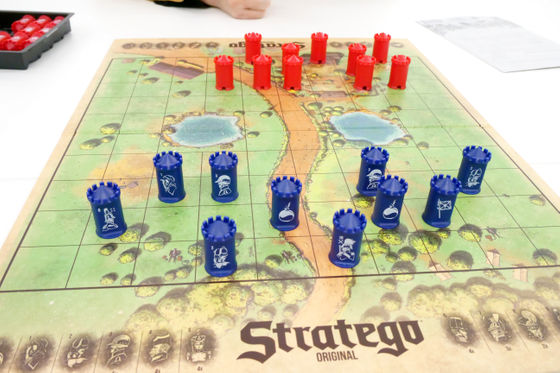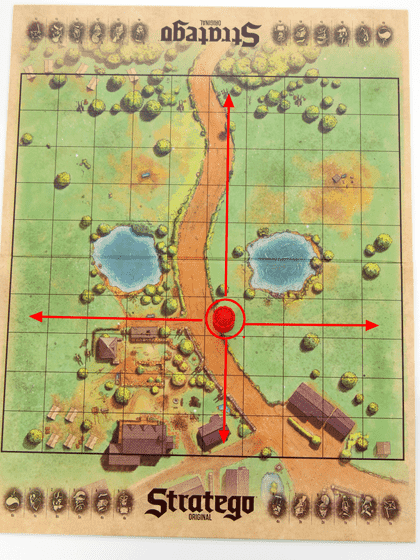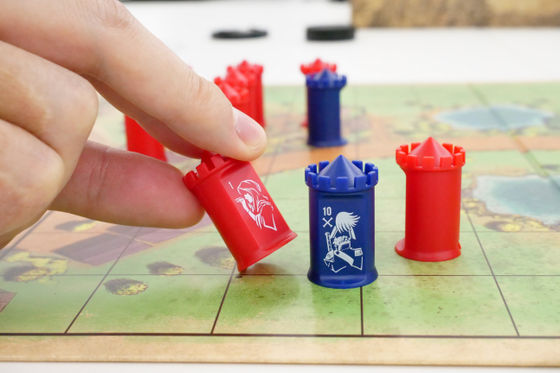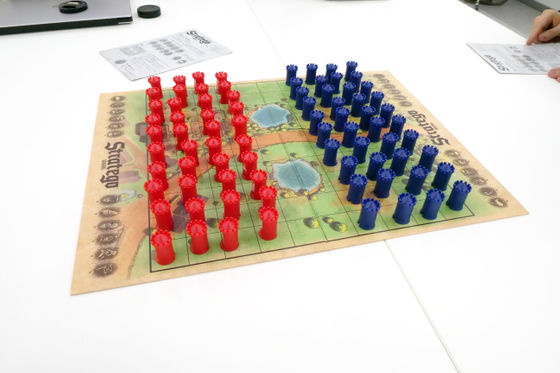A board game ``Stratego'' play review that competes for flags by engaging in psychological warfare with opponents with simple rules

Unlike chess and Go, where players can grasp the identity of each piece, a board game that fights while hiding the identity of each other's pieces is '
Stratego-Wikipedia
https://en.wikipedia.org/wiki/Stratego
The Stratego package looks something like this.

The target age is 8 years old and over, the play time is 45 minutes, and the number of players is assumed to be 2 people.

The instructions are one in English and two in Japanese. Stratego is a board game played in the United States and Europe, so the manual itself is in English, but the Stratego you play this time also comes with something translated into Japanese, so even if you don't understand English, it's OK.

Below the instructions is a folded field. It looks like this when expanded.

When you take the field folded in half, there are 40 red and 40 blue pieces used in the game.

This is the frame (red) used in the game.

Numbers and pictures are printed on the surface of the top.

Nothing is drawn on the back.

1: Spy, 2: Informant, 3: Bomb Squad, 4: Sergeant, 5: Lieutenant, 6: Captain, 7: Major, 8: Lieutenant Colonel, 9: Colonel, 10: Highest Commander. There are also flags and bombs as special pieces.

Numbers are engraved on each case from which the frames are taken out, and it is possible to store the corresponding frames in the appropriate position.

I will play it right away. The first rule is for beginners to play with only 10 pieces. There are two types of victory conditions for Stratego: ``take the opponent's flag'' and ``take all the opponent's pieces''.
The beginner's rule uses one commander-in-chief, spy, colonel, and flag, and two bomb squads, informants, and bombs. First, place these 10 frames freely in 3 rows in front of you. At that time, by standing the box in the center, you can hide how the pieces are arranged from the opponent.

Once both players are positioned and the blinders are removed, the opponent's formation is revealed. Since the layout of the frames is free, it is characterized by individual differences in how the frames are arranged.

Red player goes first. Each player can move pieces, except flag and bomb pieces.

The piece can move only 1 square forward, backward, left and right.

Also, 2: Only the informant can be moved more than 2 squares forward, backward, left and right. However, if you move more than 2 squares, the opponent will find out that you are 2: an informant, so it is important to carefully move one square at a time in the early stages.

Attacks are possible when pieces are adjacent.

When declaring an attack, declare the number of the piece to each other and show the illustration side of the piece to each other. At that time, the one with the larger number wins.

Defeated pieces are returned to the case.

Also, if you attack a bomb, regardless of the size of the number, the piece that attacked will be defeated and leave the game. The bomb will remain in place.

However, there is an exception to the power of pieces, and if 3: Bomb Squad attacks a bomb, it can be ejected.

Also, only if 1: Spy attacks 10: Supreme Commander, you can defeat the opponent's Supreme Commander.

The turn progresses while repeating movement and attack.

Ultimately, the blue player's flag was attacked by the red player's bomb squad, ending the game. There is also a rule for beginners, and the playing time this time was about 25 minutes.

Next, let's play with the original rule of using all 40 pieces.

Since you can freely arrange the pieces, the formation at the start of the game is very important.

The turn progresses while repeating movement and attacking each other.

While advancing the turn, I encountered a situation like the image below. Since the few frames in the corner of the blue camp have not moved since the game started, I guessed, ``There is probably a flag in this frame.'' However, since we do not know the identity of the opponent's piece, including the location of the bomb, we cannot proceed without any measures. The closest red piece is 5: Lieutenant, so if your opponent has a bomb around the flag, your own piece will be easily destroyed. As a result of my hesitation, I couldn't make up my mind to attack the opponent's territory with this piece. This mental reading is also one of the features of Stratego.

However, while he was wondering whether to advance the frame, the blue frame attacked his own territory and declared an attack. The blue frame was the commander-in-chief, and he rushed in alone without any escorts. Moreover, the piece that was designated as the attack target was unfortunately a flag, so red lost and the game was settled. The time it took to settle was about 45 minutes.

Stratego is a game similar to shogi or chess, in which you attack while advancing your piece, but unlike shogi and chess, the pieces can only move forward, backward, left, and right, so the rules are easy to understand. Also, since the placement of pieces is left up to each player, it is necessary to build a formation while considering ``where to place the flag'' and ``how to protect the flag''.
In addition, since Stratego does not know the identity of the opponent's pieces until the pieces touch each other, strategies that include psychological elements such as bluffing and bluffing are sometimes important. I felt that 'how to reveal the identity of the opponent's piece while hiding the identity of your own piece' is the core of Stratego.

Stratego is a simple game, but it is quite tactical, with reading of the opponent's psychology and appropriate placement of pieces. One of the ways to enjoy the game is to find the optimal placement pattern of pieces by repeating the game, and it can be said that the replayability is high.
The price of Stratego played this time is 3954 yen including tax at the time of article creation, and can be purchased at Amazon.co.jp.
Amazon | Jumbo Stratego Stratego Original Strategy Battle Board Game 19816 Genuine | Board Game | Toy

You can also get Stratego from the following gift articles.
PS5, projector, webcam, etc. Goods perfect for new life GIGAZINE Spring gift large release project `` Please answer the questionnaire and bring them all! ''-GIGAZINE

Related Posts:







